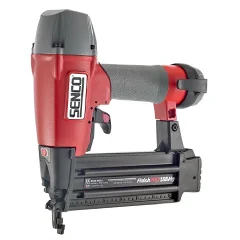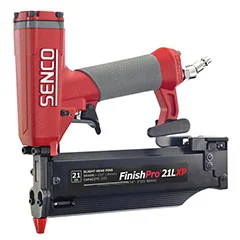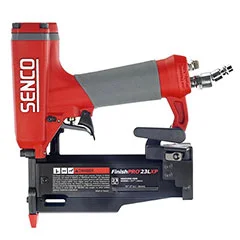How to Gauge It

Comparing Finish Nailers. 18, 21 and 23 Gauge
There’s a lot to consider when choosing the right pneumatic nailer for your job. The differences between the 18, 21, and 23-gauge may seem slight, but they make a huge difference in the outcome of your job. Let SENCO help you choose which nailer will give you the best results.
Finish and Trim Applications
For finish and trim applications, the standard tool has been the 18-gauge pneumatic nailer. Its nails are thinner in cross section than 15 or 16-gauge nailers, and as a result, they leave a smaller hole and are less likely to split narrow trim and molding.
Delicate Moldings and Prefinished Crown
When it comes to delicate moldings or prefinished crown, pros will often switch to a 23-gauge pin nailer. In these applications, an 18-gauge has a tendency to split the wood, especially hardwoods, or leave unsightly marks. Headless or slight-head 23-gauge pins are extremely thin and nearly invisible, which are distinct advantages. In some cases, however, they may not have the holding strength for a solid connection, and an adhesive could be necessary for a more permanent placement.
SENCO’s 21-Gauge
Until recently, the 18 and 23-gauge were the only choices for finish carpenters and cabinet builders. SENCO’s new 21-gauge slight/medium head nailer, the 21LXP, provides a balance of fastening strength and aesthetic advantages. For example – if your project involves MDF, and an 18-gauge is just too much firing power requiring filling and sanding on trim, consider the 21LXP. With the ability to use slight/medium head fasteners, it offers users holding power without sacrificing finish quality.
The Differences
Here is a closer look at the differences between a typical 18-gauge pneumatic nailer (FIP18BMg) and SENCO’s 21LXP and the 23LXP:

FinishPro 18BMg
Product Specifications
- Tool Weight: 2.8 lbs (1.26 kgs)
- Height: 9 13/16″ (248 mm)
- Length: 10″ (255 mm)
- Width: 2 1/2″ (63.5 mm)
- Trigger Type: Selectable Actuation
- Magazine Capacity: 100
- Fastener Range: 5/8″ – 2 1/8″
- MSRP: $79.99
FinishPro 21LXP
Product Specifications
- Tool Weight: 2.7 lbs (1.2 kgs)
- Height: 8 7/8″ (226 mm)
- Length: 7 7/8″ (200 mm)
- Width: 1 7/8″ (47 mm)
- Trigger Type: Sequential Actuation
- Magazine Capacity: 100
- Fastener Range: 5/8″ – 2″
- MSRP: $249
FinishPro 23LXP
Product Specifications
- Tool Weight: 2.7 lbs (1.2 kgs)
- Height: 8 7/8″ (226 mm)
- Length: 7 7/8″ (200 mm)
- Width: 1 7/8″ (47 mm)
- Trigger Type: Sequential Actuation
- Magazine Capacity: 100
- Fastener Range: 1/2″ – 2″
- MSRP: $229
Things to Consider
While an examination of the height, weight, length and magazine size of the respective nailers will reveal more similarities than differences, there are other factors to consider when choosing the most appropriate tool.
The 18-Gauge
The 18-gauge offers the most versatility across multiple applications and is a cost-competitive option. Plus, the widespread availability of 18-gauge fasteners is a plus. But, there are a few drawbacks to consider. Since it requires the nose piece to be depressed for actuation, an 18-gauge can leave a dent in softer wood. The thicker head of an 18-gauge nail can also mean more touch-up work, and because it’s the largest of the three finish nailers, working with an 18-gauge in tight corners can be a challenge.
The 21-Gauge
When compared to the 18-gauge, a 21-gauge pinner is more expensive, provides less columnar strength, and fastener lengths are much more limited. However, a 21-gauge balances these with quite a few pluses. It’s over a third smaller. It leaves a much smaller indent than an 18-gauge brad, improving aesthetics. Plus, it’s more compact and lightweight, is easier to maneuver in tight spaces, and its ultra-thin nose improves line of sight.
Compared to a 23-gauge pin, a 21-gauge fastener provides better shear strength and more holding power. But it’s about 10% bigger.
The 23-Gauge
The biggest advantage of a 23-Gauge micro-pinner such as the 23LXP is that its headless pins don’t require touch-up finishing, and they significantly reduce splitting on intricate woodwork. But 23-gauge headless pins are not structural, and due to the reduced holding power, adhesive may be necessary to create a permanent bond. Also, fish hooking can occur due to the 23-gauge pin’s small diameter.
Fastener Availability
Another important consideration is the availability of fasteners. The 18-gauge has the most versatility – its fasteners are widely distributed through a number of retailers. Since the 23-gauge is a more specialized tool, the fasteners might not be sold as broadly. With the recent introduction of the 21LXP and high rate of adaptation, both the slight head and headless pins are seeing increased distribution.
As you can see, there is a lot that goes into choosing the pneumatic nailer that’s just right for your job. Hopefully, taking a deeper dive beyond the specs and numbers help you to choose the nailer that will make you most effective on-site.
To learn more about these and other SENCO products, please visit SENCO.com.




